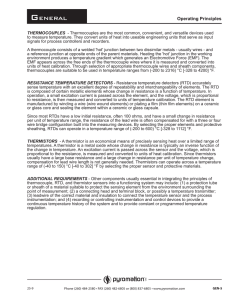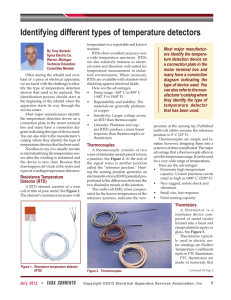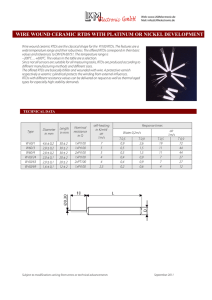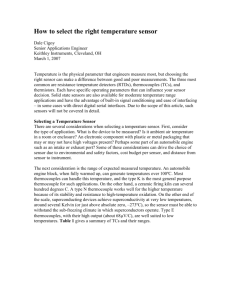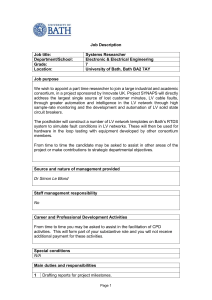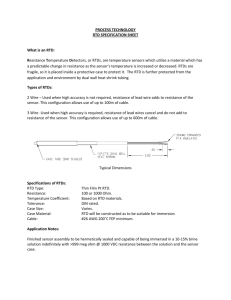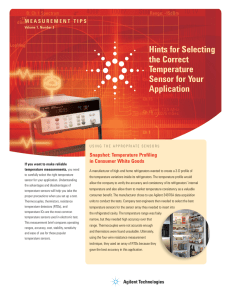RTD, Thermocouple, or Thermistor?
advertisement
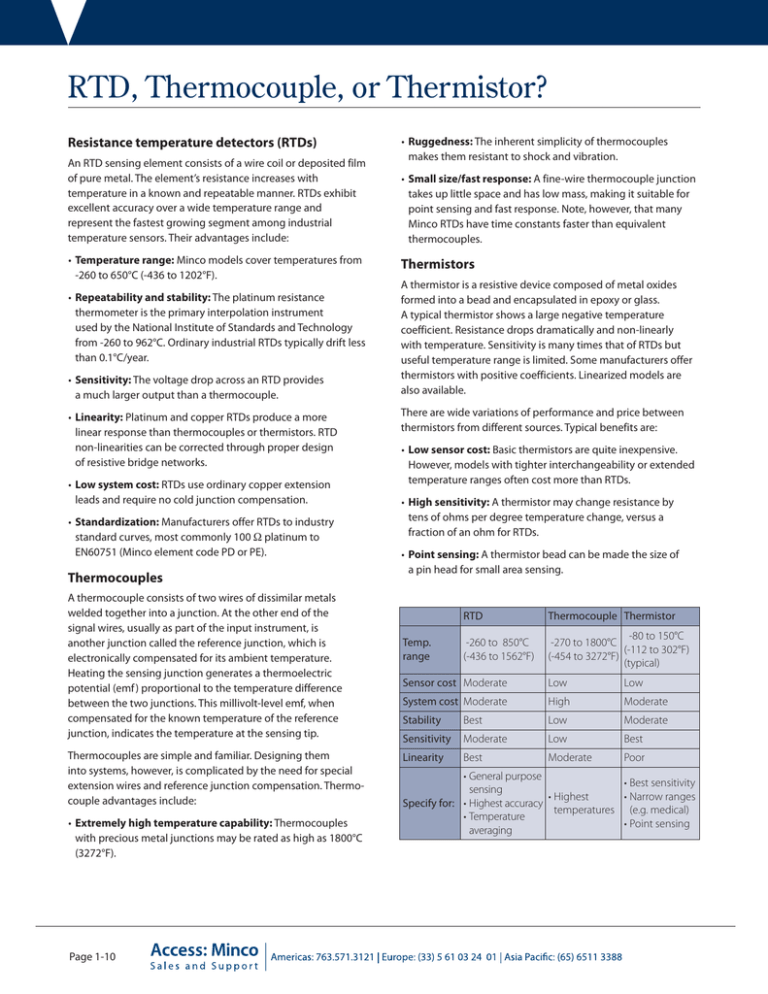
RTD, Thermocouple, or Thermistor? Resistance temperature detectors (RTDs) An RTD sensing element consists of a wire coil or deposited film of pure metal. The element’s resistance increases with temperature in a known and repeatable manner. RTDs exhibit excellent accuracy over a wide temperature range and represent the fastest growing segment among industrial temperature sensors. Their advantages include: • Temperature range: Minco models cover temperatures from -260 to 650°C (-436 to 1202°F). • Repeatability and stability: The platinum resistance thermometer is the primary interpolation instrument used by the National Institute of Standards and Technology from -260 to 962°C. Ordinary industrial RTDs typically drift less than 0.1°C/year. • Sensitivity: The voltage drop across an RTD provides a much larger output than a thermocouple. • Linearity: Platinum and copper RTDs produce a more linear response than thermocouples or thermistors. RTD non-linearities can be corrected through proper design of resistive bridge networks. • Low system cost: RTDs use ordinary copper extension leads and require no cold junction compensation. • Standardization: Manufacturers offer RTDs to industry standard curves, most commonly 100 Ω platinum to EN60751 (Minco element code PD or PE). Thermocouples A thermocouple consists of two wires of dissimilar metals welded together into a junction. At the other end of the signal wires, usually as part of the input instrument, is another junction called the reference junction, which is electronically compensated for its ambient temperature. Heating the sensing junction generates a thermoelectric potential (emf ) proportional to the temperature difference between the two junctions. This millivolt-level emf, when compensated for the known temperature of the reference junction, indicates the temperature at the sensing tip. Thermocouples are simple and familiar. Designing them into systems, however, is complicated by the need for special extension wires and reference junction compensation. Thermocouple advantages include: • Extremely high temperature capability: Thermocouples with precious metal junctions may be rated as high as 1800°C (3272°F). Page 1-10 | • Ruggedness: The inherent simplicity of thermocouples makes them resistant to shock and vibration. • Small size/fast response: A fine-wire thermocouple junction takes up little space and has low mass, making it suitable for point sensing and fast response. Note, however, that many Minco RTDs have time constants faster than equivalent thermocouples. Thermistors A thermistor is a resistive device composed of metal oxides formed into a bead and encapsulated in epoxy or glass. A typical thermistor shows a large negative temperature coefficient. Resistance drops dramatically and non-linearly with temperature. Sensitivity is many times that of RTDs but useful temperature range is limited. Some manufacturers offer thermistors with positive coefficients. Linearized models are also available. There are wide variations of performance and price between thermistors from different sources. Typical benefits are: • Low sensor cost: Basic thermistors are quite inexpensive. However, models with tighter interchangeability or extended temperature ranges often cost more than RTDs. • High sensitivity: A thermistor may change resistance by tens of ohms per degree temperature change, versus a fraction of an ohm for RTDs. • Point sensing: A thermistor bead can be made the size of a pin head for small area sensing. Temp. range RTD Thermocouple Thermistor -260 to 850°C (-436 to 1562°F) -80 to 150°C -270 to 1800°C (-112 to 302°F) (-454 to 3272°F) (typical) Sensor cost Moderate Low Low System cost Moderate High Moderate Stability Best Low Moderate Sensitivity Moderate Low Best Linearity Best Moderate Poor • General purpose • Best sensitivity sensing • Highest • Narrow ranges Specify for: • Highest accuracy temperatures (e.g. medical) • Temperature • Point sensing averaging
